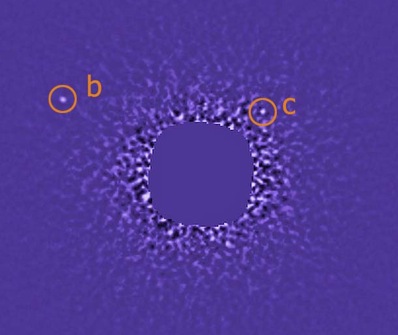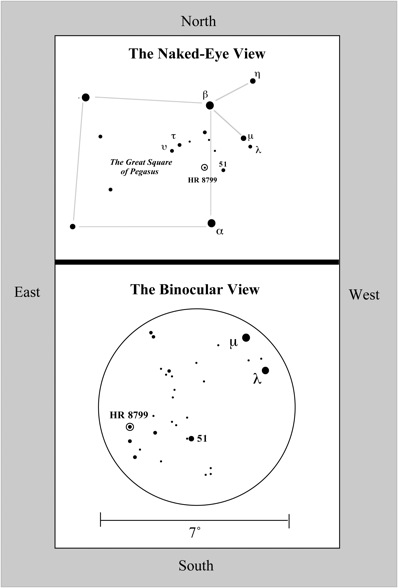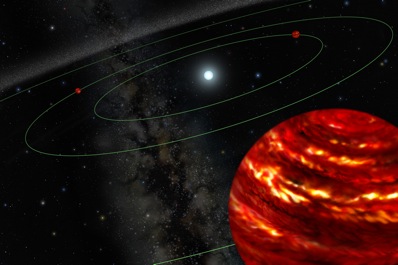Astronomers using the Gemini North telescope and W.M. Keck Observatory on Hawaii's Mauna Kea have obtained the first images of a multi-planet system around a normal star.
"We finally have an actual image of an entire system. This is a milestone in the search and characterisation of planetary systems around stars," says Bruce Macintosh of the Lawrence Livermore National Laboratory.

Gemini Observatory discovery image showing two of the three confirmed planets indicated as b and c. b is the ~7 Jupiter-mass planet orbiting at about 70 AU; c is the ~10 Jupiter-mass planet orbiting the star at about 40 AU. Due to the brightness of the central star, it has been blocked and appears blank in this image to increase visibility of the planets. Image: Gemini Observatory
The new solar system orbits a dusty young star known as HR 8799, which is 140 light years away and about 1.5 times the size of our Sun and five times more luminous. Three planets, two roughly ten times and one seven times the mass of Jupiter orbit the star at distances equivalent to 24, 37 and 67 times the Earth-Sun separation (1 astronomical unit, or AU). Moreover, the size of the planets decreases with distance from the parent star, much like the giant planets do in our own Solar System. The furthest planet in the system orbits just inside a disc of dusty debris, similar to that produced by the comets of the Kuiper belt of our Solar System, just beyond the orbit of Neptune at 30 AU. The discovery team have commented that the system seems to be a scaled up version of our Solar System orbiting a slightly larger and brighter star.
"Seeing these planets directly – separating their light from the star – lets us study them as individuals, and use spectroscopy to study their properties, like temperature or composition," says Macintosh. "We can see some evidence for complex cloud structure in their atmosphere and soon we'll be able to get spectra, and say something about composition."
Using the Gemini North telescopes, the international team made the initial discovery of two of the planets in the planetary system in October 2007. Follow-up observations with the Keck II telescope confirmed the discovery and discerned a third planet orbiting even closer to the star. In both cases, adaptive optics technology – with a resolution of 0.4 seconds of arc – was used to correct in real-time for atmospheric turbulence to obtain these historic infrared images of an extrasolar multiple planet system.

Naked eye and binocular finder charts for HR 8799. The host star is faintly visible to the naked eye, but only to those who live well away from bright city lights or have a small telescope or even binoculars. Image: Gemini Observatory Illustration by Stephen James O'Meara.
"Until now, when astronomers discover new planets around a star, all we see are wiggly lines on a graph of the star's velocity or brightness. Now we have an actual picture showing the planets themselves, and that makes things very interesting," says Macintosh.
The host star is a bright, blue, A-type star, which are often ignored in ground and space-based direct imaging surveys since they offer a less favorable contrast between a bright star and a faint planet. But their advantage over the Sun is that they can retain heavy discs of planet-making material and therefore form more massive planets at wider separations that are easier to detect. Indeed, as Ben Zuckerman of UCLA comments: "HR 8799's dust disc stands out as one of the most massive in orbit around any star within 300 light years of Earth." HR 8799 is also young – less than 100 million years old – which means its planets are still glowing with heat from their formation.
The observations of HR 8799 form part of a larger survey of 80 such young, dusty and massive stars located in the solar neighborhood. This discovery was made after observing only a few stars, which may lead to the conclusion that Jupiter-mass planets at separations similar to the giant planets of our Solar System are frequent around stars only a bit more massive than the Sun. What is certain is that HR 8799's planetary system will be studied in great detail in the years to come, and will undoubtedly be a prime target for next-generation exoplanet-finding instruments and dedicated space missions. Ultimately, astronomers are working towards images and spectroscopic studies of truly Earthlike planets.

Artist impression of the multiple planet system, that hosts three planets of 10, 10 and 7 times Jupiter mass. Image: Gemini Observatory Artwork by Lynette Cook.
"After all these years, it's amazing to have a picture showing not one but three planets. The discovery of the HR 8799 system is a crucial step on the road to the ultimate detection of another Earth," says Macintosh. "I think there's a very high probability that there are more planets in the system that we can't detect yet. One of the things that distinguishes this system from most of the extrasolar planets that are already known is that HR 8799 has its giant planets in the outer parts – like our solar system does – and so has 'room' for smaller terrestrial planets – far beyond our current ability to see – in the inner parts."
from:http://astronomynow.com/081114Planetfamilyphotographedaroundnormalstar.html





 RSS Feed (xml)
RSS Feed (xml)